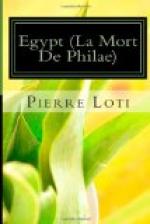Even the old Nile has allowed itself to be fretted and brought up to date in the progress of evolution.
First, the women, draped in black veils, who come daily to draw the precious water, have forsaken the fragile amphorae of baked earth, which had come to them from barbarous times—and which the Orientalists grossly abused in their picture; and in their stead have taken to old tin oil-cans, placed at their disposal by the kindness of the big hotels. But they carry them in the same easy graceful manner as erstwhile the discarded pottery, and without losing in the least the gracious tanagrine outline.
And then there are the great tourist boats of the Agencies, which are here in abundance, for Assouan has the privilege of being the terminus of the line; and their whistlings, their revolving motors, their electric dynamos maintain from morning till night a captivating symphony. It might be urged perhaps against these structures that they resemble a little the washhouses on the Seine; but the Agencies, desirous of restoring to them a certain local colour, have given them names so notoriously Egyptian that one is reduced to silence. They are called Sesostris, Amenophis or Ramses the Great.
And finally there are the rowing boats, which carry passengers incessantly backwards and forwards between the river-banks. So long as the season remains at its height they are bedecked with a number of little flags of red cotton-cloth, or even of simple paper. The rowers, moreover, have been instructed to sing all the time the native songs which are accompanied by a derboucca player seated in the prow. Nay, they have even learnt to utter that rousing, stimulating cry which Anglo-Saxons use to express their enthusiasm or their joy: “Hip! Hip! Hurrah!” and you cannot conceive how well it sounds, coming between the Arab songs, which otherwise might be apt to grow monotonous.
*****
But the triumph of Assouan is its desert. It begins at once without transition as soon as you pass the close-cropped turf of the last square. A desert which, except for the railroad and the telegraph poles, has all the charm of the real thing: the sand, the chaos of overthrown stones, the empty horizons—everything, in short, save the immensity and infinite solitude, the horror, in a word which formerly made it so little desirable. It is a little astonishing, it must be owned, to find, on arriving there, that the rocks have been carefully numbered in white paint, and in some cases marked with a large cross “which catches the eye from a greater distance still"(sic). But I agree that the effect of the whole has lost nothing.
In the morning before the sun gets too hot, between breakfast and luncheon to be precise, all the good ladies in cork helmets and blue spectacles (dark-coloured spectacles are recommended on account of the glare) spread themselves over these solitudes, domesticated as it were to their use, with as much security as in Trafalgar Square or Kensington Gardens. Not seldom even you may see one of them making her way alone, book in hand, towards one of the picturesque rocks—No. 363, for example, or No. 364, if you like it better—which seems to be making signs to her with its white ticket, in a manner which, to the uninitiated observer, might seem even a little improper.




